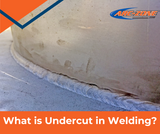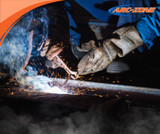
What Is Stick Welding? Your in-Depth Guide
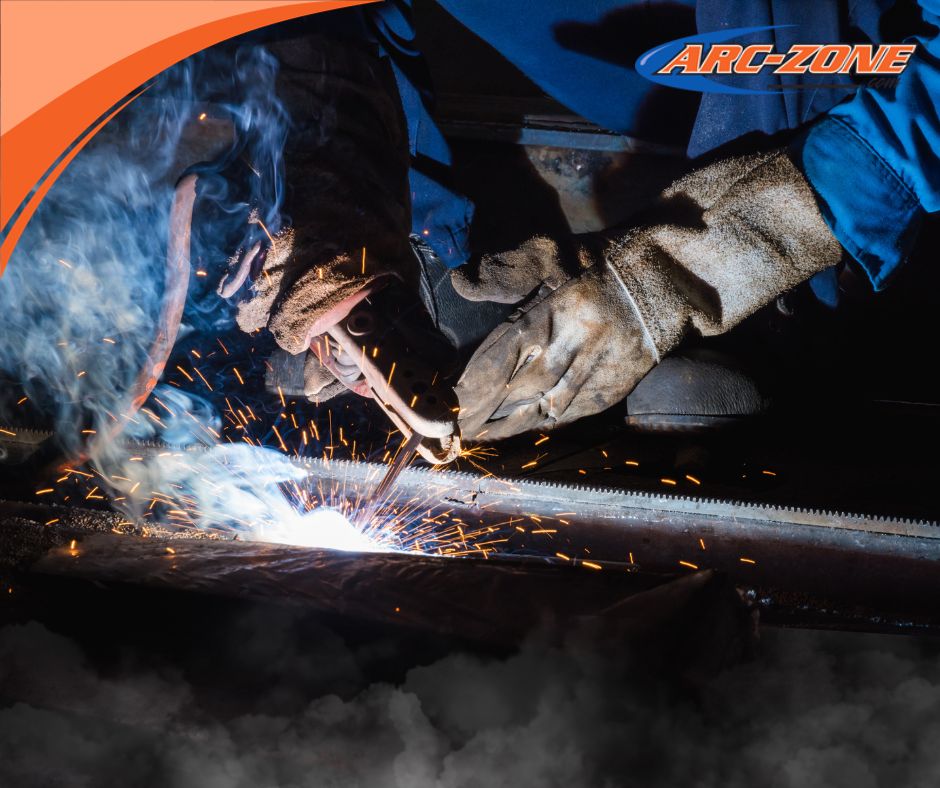
Stick welding is an informal way of referring to shielded metal arc welding (SMAW), manual electrode welding, manual arc welding, manual metal arc welding (MMA), or flux-shielded arc welding.
Regardless of what you call it, this method is typically the first welding process taught to a person when they start training.
Stick welding is easier to learn than other types of welding and requires a less expensive and simpler setup for those who don't want to deal with a gas tank.
A bit more complex than MIG welding and far less complicated than TIG welding, if you can learn to stick weld, all other welding processes are easier to pick up.
There are a variety of arc welding methods, but stick welding is one of the oldest types of welding still used today.
It's also one of the most popular and commonly used welding processes by both professional welders and hobbyists. Stick welding is also quicker and dirtier than other types of welding.
Using an anode and an electric current at the weld pool to join a variety of different metals, SMAW (or stick welding) offers versatility and doesn't need shielding gases.
Fluctuations in temperature don't interfere with the stick welding process, which is why it can easily be performed outdoors, making it the go-to weld in countless industries.
What Is Shielded Metal Arc Welding Used For?
Most commonly used in steel structures and pipeline work, shielded metal arc welding (SMAW), or stick welding, provides a lot of versatility.
SMAW can be used on a wide array of metal alloys including the following:
- Copper
- Iron
- Aluminum
- Nickel
- Cast iron
- Carbon steel
- Low and high alloy steels
- Stainless steel
Since it's easy to set up and highly portable, metal arc welding is utilized in a broad array of industries like manufacturing, construction, mining, structural welding, shipbuilding, oil, and steel fabrication.
On-site repairs often use this method thanks to its resounding durability and cost-effectiveness.
While some industries prefer to use MIG welding, stick welding (or manual metal arc welding) is the preferred method adopted by people doing portable repairs and those who own smaller manufacturing shops.
It's also the most proficient when it comes time to weld thicker materials.
How Is Manual Metal Arc Welding (MMA) Done?
The definition of MMA, or stick welding, is using a power source to generate a continuous electric arc between a flux-coated rod in an electrode holder and the metal structures you're working on.
The electrode is struck like a match against the metal to ignite it and then melted into that joint, creating the weld itself, the arc burning between the rod, and the piece you're working on.
No external shielding gas is required because the flux coating behaves as the protective layer on the weld. The filler rod shortens as the welding continues.
The coating of protection the electrode leaves in its wake is called the slag, and this slag should be taken off after the weld cools, exposing the clean weld.
It takes practice to strike a clean arc, and some electrodes are more difficult to start than others, so getting accustomed to the way the electrode melts can take time.
You must learn to move with the metal electrode. If you don't, your arc length will be too long, which could lead to the electrode going out.
How Do You Start Stick Welding?
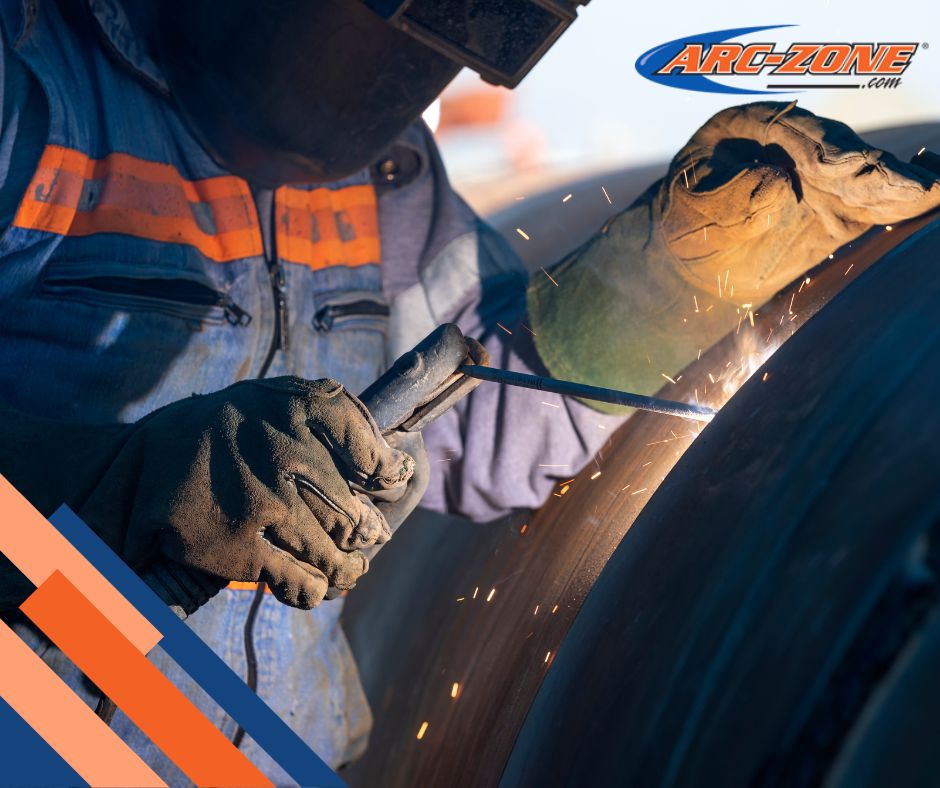
The equipment needs are pretty basic for MMA welding or stick welding.
Devices can operate with the power found in most residential outlets which is why stick welding is so popular among hobbyists.
You'll need the following to get started:
- A power supply.
- Welding cables that have an electrode holder.
- The right electrodes.
- A stick welding machine where you can set the amps you need.
- Appropriate safety gear.
No shielding gas is required since the welding electrode coating produces the shielding gases and slag over the weld metal pool.
The Welding Electrode Coating
The welding electrode coating protects the weld from the air around it, produces the slag that supports the weld itself, and allows the arc to be created with greater ease.
The electrode covering is important to the quality of the electrode, itself, and the quality of your weld.
NOTE: Always check to see if the coating on the electrode is intact!
Welding electrodes are straight welding wires coated with filler materials. With a set length, they have a fixing head to attach to the electrode holder and an ignition head to ignite the arc.
Electrode Diameter
The electrode diameter references the diameter of the metal rod found inside of the electrode, and this determines the amount of electrical current that can be utilized with it.
- A larger electrode diameter means a greater amount of current.
- A smaller diameter means it has a smaller carrying capacity.
The electrodes come in various sizes and classifications to support every type of weld.
Getting Started
First, match up the parent metal with the electrode and select the correct size for the thickness of the intended weld.
You can find the classification stamp on the end of each electrode which then fits into the electrode holder.
While you're welding, pay attention to the length of the arc, and keep it as short as you can.
The electrode will decrease in size as the weld continues and the arc increases. This movement can be hard to control, but it gets easier with practice.
Using a chipping hammer and a steel burhs, remove the slag the welding electrode leaves behind when it runs out and cools.
If you have to continue the weld with a new electrode, start ahead of the former weld, move back to the previous, and then continue onward.
Is Stick and TIG Welding the Same?
Stick welding and tungsten inert gas (TIG) or gas tungsten arc welding (GTAW) are welding techniques that use helium or argon (inert gases) around the weld joint to stop any oxidation from occurring.
The biggest difference between these two types of welding comes down to the electrode.
TIG Welding
TIG welds use a tungsten electrode creating an electric arc in between the metal and the torch.
Tungsten contains a higher melting point of upwards of 6,000° F, and this tungsten electrode is not consumed during the welding process, allowing the welds to create a stable electric arc and yielding a durable, clean weld.
Stick Welding
When stick welding, you use a consumable electrode that melts to form part of the weld and acts as the filler metal.
The rod/electrode contains a flux coating which creates a protective barrier to hinder any atmospheric contamination.
The electrode coatings in stick welding also house an inert gas, eliminating the necessity of having an external gas supply.
Stick welding produces more spatter than TIG and other welding methods and regularly leaves a weld that's not as clean.
Is Stick Welding Easy?
Although some projects may require special materials and equipment, the process of stick welding remains quite easy.
To be a good stick welder, you need to be consistent and maintain both welding speed and a stable arc as you move over the base metal.
The distance between the metal surface and the arc burns needs to remain constant throughout to stop any sudden drops in voltage or a "pop out" from happening. This happens if the electrode is moved too far away from the base metal.
Having a steady hand when the electrode gets incredibly hot will prevent you from creating any irregularities within the weld. A good weld is smooth and contains no inconsistencies or slag.
You can purchase machines that are dedicated to stick welding, although almost every welding machine can also produce a stick weld.
The dedicated machines have only one setting, an amperage knob, making them easy for beginners to use.
What Are the Advantages of Stick Welding?
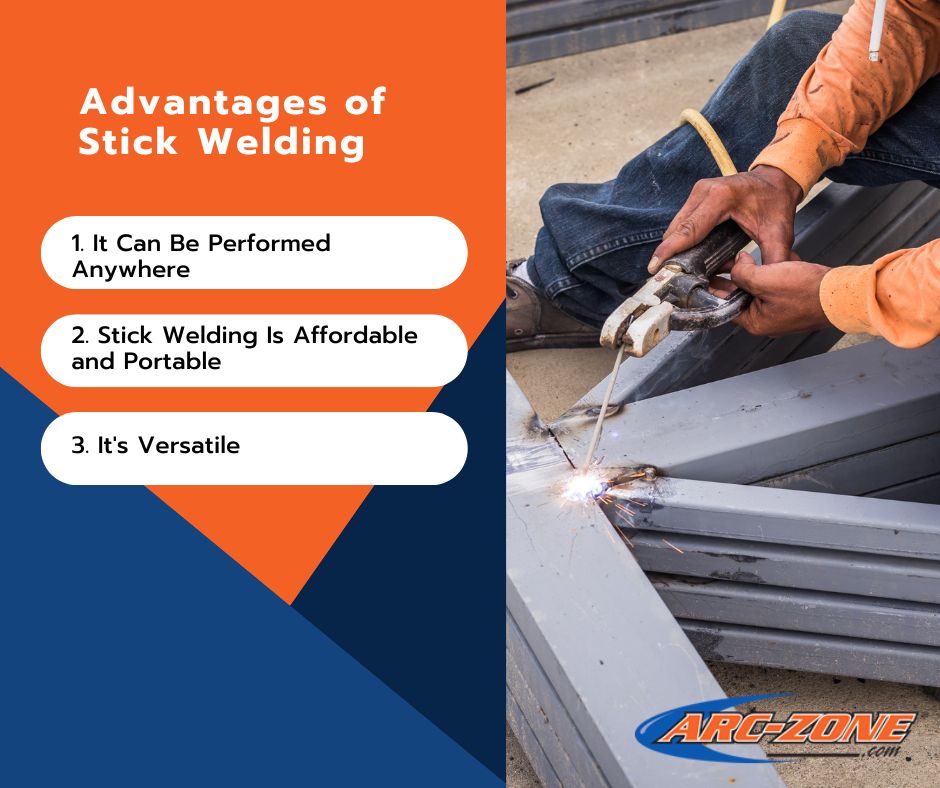
1. It Can Be Performed Anywhere
Stick welding can be performed indoors, outdoors, and even underwater as it's both wind and water-resistant.
MIG and TIG welding both use external shielding gas, so they can only be done indoors because any amount of rain or wind will cause issues with the weld.
If air enters into the arc during a weld, this causes air bubbles to form inside the molten metal, weakening the weld and making it visually unappealing.
2. Stick Welding Is Affordable and Portable
Thanks to the small list of basic equipment needed, stick welding is much more affordable to do than most other welding processes, and the small amount and type of equipment needed also make it portable.
3. It's Versatile
Stick welding can be used on a wide variety of metals because it's easy to change rods, making it amenable to countless industry needs. It even works well on dirty metal!
What Are the Disadvantages of Stick Welding?
The disadvantages to the manual arc welding method or stick welding are few, but they should be noted.
1. Thinner Metals Are Impossible to Weld
It's impossible to weld aluminum and thinner metals and typically there's much more molten splatter, meaning extra cleanup of the slag when you're finished with the weld.
This slag must be chipped away.
2. It's a Slower Process
Stick welding can be a slower process than other types of welding, making arc stability an imperative skill to master if you desire a clean weld.
3. The Electrodes Are Consumable
Thanks to the use of consumable electrodes, these items will need to be replaced frequently.
What Does the Process of Stick Welding Entail?
Before you begin the manual metal arc welding (MMA) or stick welding process, some grinding and cleaning may be necessary, depending on whether the surface you intend to weld has grease or paint on it.
If you want a high-quality weld, consider the work angle, the travel angle and distance, and the travel speed.
Keep your electrode at a 45-degree angle to the weld joint, maintaining a constant distance of almost 1/8 of an inch from the tip of the electrode to the base metal.
Strike the tip like a match at the start of the weld to ignite the arc.
At this point, the most common errors are using the wrong torch distance from the weld or moving too fast. Your welding speed should be constant.
TIP: If you make either of these mistakes, your weld can wind up full of contaminants. Always keep a wire brush handy for cleaning out the finished weld!
Welding Positions
Each welding position can be achieved with stick welding but the type of filler metal will change. While some filler metals can only be used in flat and horizontal, others can be used in all positions.
Each has a designated code that will tell you where and how it can be used.
To help welders comprehend the weld position and type of weld joint needed, each has also been designated a number for the position and a letter, F or G, for the type (fillet or groove).
1. Flat/Weld Position 1
Because you're not fighting gravity, flat is typically the easiest welding position. The weld pool will stay liquid and evenly wet the joints of the weld.
TIP: Using stick welding in this position will produce slag, so try utilizing a drag-over-push technique to improve the result.
2. Horizontal Position/Weld Position 2
Welds done in this position are similar to the flat welding process, however, it's best not to run too hot because a weld pool with extra liquid can easily get pulled down.
3. Vertical/Weld Position 3
Ensure you're in a comfortable position before starting a vertical weld. This type of weld is more difficult than a flat or horizontal.
TIP: Practice on a piece of scrap metal first so you know the technique and parameters you're using to give you the desired result.
4. Overhead/Weld Position 4
This type of weld is typically used when the item in question can't be moved. Vertical and overhead welding are very similar.
Again, find a comfortable position in which to undertake the welding process. You need to be sure you have the range of motion needed to complete the job.
TIP: This position means sparks will inevitably fall on you, so have the correct safety equipment and extra protection for the top of your head. Your welding jacket should be made of leather to keep you protected.
Simple Tips to Improve Stick Welding
1. Make Sure You Have Enough Amperage
If not, the electrode will get sticky, making it hard to strike an arc without getting stuck. Without the proper amperage, it is impossible to melt the core wire.
2. Remember That if There Is slag, You Must Drag
That solid layer of flux that sits over the weld metal is slag, and when stick welding, you should drag or use the pulling technique—not push.
3. Clean Before You Weld
Porosity occurs when a gas or other contaminant gets into the weld pool creating a cavity. Remove any rust, moisture, paint, grease, or scale from the surface.
Slow down the travel speed to let gas bubbles boil out of the molten metal before solidification.
4. Stop the Spatter
Excessive spatter makes for a shoddy-looking weld and can increase the price of cleaning. Although it doesn't affect the tensile strength of the weld, there are ways to keep it under control.
Try shortening the arc length or lowering the welding current, keeping the electrical voltage of the power supply in the range for both the size and type of electrode.
5. No Wet Electrodes
When you experience an erratic, rough arc, your electrodes might be wet.
Make sure you're using the correct power source polarity and abide by the manufacturer's recommendations, and then check your electrodes.
Try taking one from an unopened container. If this is a problem you keep having, you can store electrodes in proper containers or a heated cabinet to keep them from getting moist.
Necessary Equipment for Stick Welding
With the help of Arc-Zone, you can take advantage of our vast supply of state-of-the-art welding equipment and find everything you need for your next stick welding project.
Safety First
There are several things you can't do without when it comes to welding and a safe welding helmet is one of them.
You'll also need an appropriate welding jacket for women or men, and gloves like AngelFire™ Women’s MIG/Stick Welding Gloves or Heavy-Duty MIG/Stick Welding Gloves From Miller.
If you plan on welding indoors, you should also use a respirator to keep your lungs clear of any hazardous inhales.
Stick Welding Shopping List
If you don't already have all of the necessary equipment, this is a good place to start.
Arc-Zone can set you up with everything you need to fill in the missing items you don't have in your welding arsenal.
Start with the basics like a Stick Welding Machine, pick up a Spring Electrode Holder or a Twist Electrode Holder, and Rod Guard Canisters and Accessories which provide great storage and inventory control for all of your stick welding electrodes, TIG rods, and filler metals.
These solutions are designed to keep your welding wire organized and protected, minimizing atmospheric contamination.
Find the widest variety of Flux Coated Welding Electrodes to meet all of your welding needs, and don't forget to pick up the stainless steel Wire Brushes for cleaning the slag, along with everything else you might need for stick welding.
Get in Touch With Arc-Zone
If you have any questions about equipment or the welding process, don't hesitate to contact our team of professionals.
We're known for outstanding customer service and support and are here to answer any of your welding questions!
Call Us: (760) 931-1500 or Email Us: sales@arc-zone.com.
Conclusion
Whether you call it SMAW, manual electrode welding, manual arc welding, MMA, or stick welding, this type of welding is a great place to start your training and mastering the art of welding.
Inexpensive, portable, and simpler than other types of welding, there's a reason stick welding remains popular for a wide range of welding jobs.
Recent Posts
-
ARC-ZONE.COM & RICO ABREU RACING ANNOUCE A MULTI-YEAR PARTNERSHIP
Vista, CA – Arc-Zone.com, a pioneer in the metal fabrication industry for the past 25 years, is thri …Dec 15th 2023 -
What Is Undercut in Welding?
You know how frustrating it is to find an undercut in your work, but what exactly is undercutting in …Nov 21st 2023 -
What Is Stick Welding? Your in-Depth Guide
Stick welding is an informal way of referring to shielded metal arc welding (SMAW), manual …Nov 13th 2023

 Jim Watson
Jim Watson
